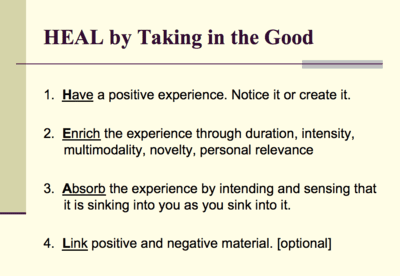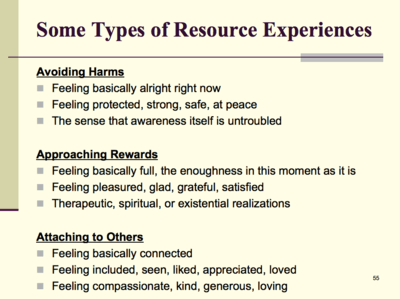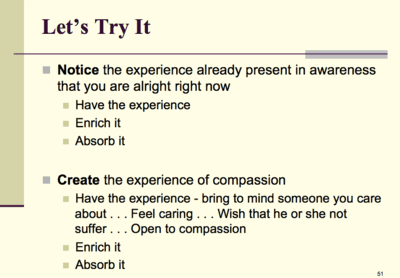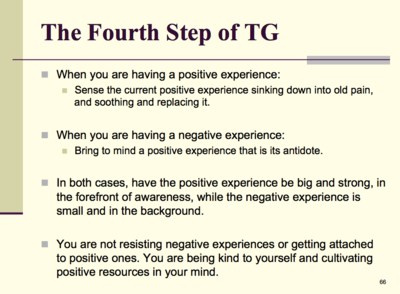As people internalize experiences of gratitude, they gradually become less greedy, less driven to prove themselves. Learn to hardwire your happiness.
Download this Audio Meditation for Free, Just Enter Your First Name and Email Address:
Hardwiring Happiness
From Dr. Rick Hanson:
“I think it’s really interesting that generally speaking when people internalize experiences of feeling fundamentally safe and protected and all right, right now and strong and efficacious, that they’re a hammer instead of a nail. As people do that, they actually gradually become less fearful and angry and less combative toward others.
Also as people repeatedly internalize experiences of gratitude or gladness or accomplishment or everyday pleasures of the body; drinking water when you’re thirsty, putting on a jacket when you’re cold, snuggling into bed when you’re tired, chocolate etc., as people really internalize those experiences including the fullness of this present moment they gradually become less greedy, less grasping, less driven to attain goals and prove themselves.
And also, as people repeatedly internalize feelings of being included or seen or appreciated or liked or loved, cared about or people repeatedly internalize experiences of feeling loving, compassionate, kind, seeing a good and others, seeing the good in themselves and also as people internalize experiences of self-worth as confidence.
Guess what also happens? They tend to be less envious, jealous, hateful, aggressive, discriminating, prejudiced, and warlike toward other people. And that’s the segway really into the second question which the person raised; How do we be in the world and engage efforts which are so often based on stress and drivenness and fear and anger and striving to impress other people and become important. Takes one to know one time. I know about this way of being often. How do we aspire, how do we engage life fully, how do we be ambitious without tipping into the dark side?
So, I want to talk about that. OK so far?
So, one way to do this is to think in terms of the evolution of the brain, brainstem, subcortex, cortex, loosely associated with the reptilian, mammalian and primate human stages of evolution. Or to put a little differently as a kind of metaphor that’s very simplistic. Inside each one of us, I certainly recognize it inside myself, there is a little lizard, a little mouse and a little monkey.
And again, being very kind of metaphorical but it’s an easy way to just sort of register this and explain it to other people, as the brain evolved in these three stages, lizard, mouse, and monkey, so did our capacities to meet the three fundamental needs of any animal including a complicated animal like us loosely associated with these stages of evolution the brain has become more effective at meeting our fundamental needs for safety, satisfaction and connection.
We have these three overarching needs that are managed by three overarching systems that help us be safe by avoiding harms, help us be satisfied by approaching rewards and help us be connected by attaching to others. These are three very familiar ideas in psychology. Three very familiar motivational systems; avoiding pain, approaching pleasure and attaching to others.
So, we have these three needs, three systems and basically again to simplify, the brain has two settings. It has two ways of going about meeting these needs. So, we have three needs and two modes or settings or ways of meeting these needs.
In the first case, when people experience that their needs are met, the brain defaults to its resting state, it’s sustainable equilibrium in which the body repairs and refuels itself and recovers from bursts of stress and the mind is colored in terms of safety, satisfaction and connection with the general sense in three umbrella words of peace, contentment and love.
That’s what others and I have called the responsive mode of the brain or to simplify, the Green Zone. That’s kind of good news. That’s the equilibrium condition of the body-mind system.
On the other hand we’ve also evolved a second mode, a second way of meeting our safety needs in which when we feel that one or more of these core needs is not met we don’t feel safe in our core or we don’t feel satisfied or we don’t feel loved or connected to others, the brain fires up in terms of a fight or flight response or really freezes in terms of over activation of the parasympathetic wing of the nervous system and we move into what others and I have called the reactive setting of the brain, the reactive mind or the red zone in which bodily resources are burned, long term projects are put on hold and there’s a sense of destabilization in the body.
It’s a departure from equilibrium and in three umbrella terms the mind is colored by a sense of fear, frustration, and heartache in terms of safety, satisfaction and connection.
Now, if you have a familiarity with the four noble truths of Buddhism, you might recognize that the Green Zone is a kind of summary neuropsychological operationalization of the third noble truth. There’s not much sense of craving there. Why.? Because the causes of craving are not so present. What are the causes of craving? The causes of craving from a biological neuropsychological standpoint are predominantly a sense of deficit or disturbance.
When you’re in the Green Zone when you experience that your basic needs are being met, there’s a sense of fullness and ease rather than deficit or disturbance. The reactive mode, the red zone, is a very summery neuropsychological operationalization of the second noble truth because then there’s a sense of deficit and disturbance which drives craving. I try to work backward. What in the world is going on in the brain of a Buddha or a saint or someone far along in practice or ourselves in a really good day? And then figure out, OK how can we stabilize that state by repeatedly experiencing it, activating that state or various factors of it and then installing them in the brain.
In other words through repeatedly having responsive mode, Green Zone experiences, and installing them in your brain you become increasingly able to engage life on the basis of an already internalized, increasingly unconditional, increasingly independent of external contingencies, internalized felt sense of peace, of strength, of feeling protected, of contentment, of feeling already fulfilled, already rewarded, already accomplished, already grateful and glad and an increasingly internalized felt sense of love, already feeling loved enough, already feeling included, already feeling of value instead of ashamed and feeling loved and compassionate toward other people.
See the big picture there? And for me that creates a fantastic path with heart, a beautiful path repeatedly internalizing responsive mode experiences when they’re authentically available to us is a beautiful way to fill ourselves up on the inside out and gradually undo the underlying causes of craving. To put it in a summary way, cultivation undoes craving.
We can still engage life. Aspire, protect ourselves and those we care about, work things out with other people, but we don’t do it on the basis of fear, frustration, and heartache, not at least in our core. Red thoughts and feelings and desires may arise in a generally Green brain.
And my personal hope is that somehow, we’re going to get a critical mass of brains. My rough number’s a billion, kind of stuck in the Green Zone, engaging life, speaking truth to power, sticking up for themselves, asserting themselves, writing books, building companies, building houses, planting trees and whatnot, but a billion brains on Green I think would change the course of human history.
So, to really really summarize it, and then I’ll hear what you have to say and then we’ll do a little practice with this, pet lizard, feed the mouse and hug the monkey.
MEDITATION
… Relaxing as you exhale.
Recognizing that you’re in a protected setting among good people. You’re also a strong person, you have strengths that can enable you to deal with challenges so that you can afford to let unnecessary anxiety fall away.
Letting unnecessary bracing or guarding or tension or vigilance fall away. Letting any unfounded sense of threat fall away. And coming home and resting more and more deeply in a growing sense of peace. A level of peace, a space of peace that can contain anxiety or uncertainty.
With peace at your core.
Letting a growing sense of peace move to the back of the mind and focusing now on encouraging gently and authentically a growing feeling of contentment, a sense of well-being with no wish for this moment to be any other than the way it is. You can help grow this sense of contentment by bringing to mind things that you feel grateful for or glad about.
Encouraging feelings of gratitude or gladness to fill your mind.
Thinking of things that make you feel happy or contented.
As contentment grows, there’s a falling away of any frustration or disappointment or drivenness. No need for any of that.
And then let this sense of contentment move to the back of the mind. And finding a growing sense of love, calling to mind beings who care about you even if it’s an imperfect relationship.
Calling up experiences of feeling included or liked or loved.
Opening to receive these experiences of feeling liked or loved. Being warm and caring toward yourself to let yourself actually feel these things.
Also, being aware of your own warm-heartedness, your compassion and kindness and caring and love for others.
Loved and loving.
And as your mind and heart and body are increasingly filled with love, there’s a falling away of any kind of struggle with other people, envy falls away, hurt falls away. Any kind of chasing of others or trying to be important or impressive, all of that falls away, no need for it.
Greening the heart in effect with love.
And then as we take just a few more moments to finish up, a more global or integrated sense of peace, contentment and love altogether. Your home base, a sense of coming home. Disturbance or deficit falling away. Craving falling away. Present, here, at home.
There’s a saying in Tibet and elsewhere that if you take care of the minutes the years will take care of themselves. And that’s our opportunity. Minute by minute, breath by breath, to see the good that is available to us and to be a friend to ourselves in part out of service to others to grow the good over here, so we have more to offer to them. And to look for that good and really letting it land and coming into an intimacy with it for many reasons, simply to enjoy life more, to show up more for the good that’s here instead of missing it as it goes on by.
Also, to grow various resources, psychological resources and our strengths inside to deal with life, to be more effective, to be more successful, to be more skillful in relationships, to do that. And also, if this interests you, to gradually internalize so much good inside that craving falls away, there’s less and less of a basis for it. There’s no basis for it. And you’re more and more able to, as it said, walk increasingly evenly over uneven ground through equanimity.
Not underestimating the power of little experiences gradually internalized and accumulated over time.
Quoting the Buddha here he said, “Think not lightly of good, saying it will not come to me. Drop by drop is the water pot filled. Likewise, the wise one gathering it little by little fills one’s self with good.”
May you and I fill ourselves with good. May we help others fill themselves with good for our own sake and in widening ripples known and unknown seen and unseen eventually hopefully helping the whole wide world.”
Download this Audio Meditation for Free, Just Enter Your First Name and Email Address:
More from: Rick Hanson













